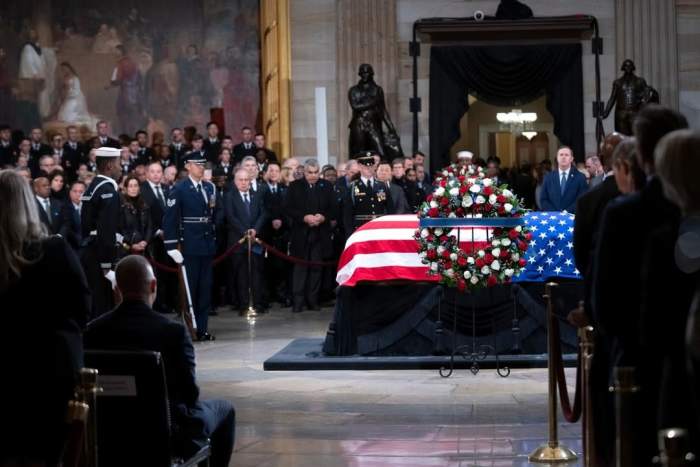te: we are republishing this story which originally made the news in January 2025.

Jimmy Carter’s coffin at his funeral, Photo Credit: vp/Instagram
Note: We are republishing this story, which originally made headlines in January 2025.
When news first broke about the viral image from Jimmy Carter’s funeral, it wasn’t long before the internet caught fire. A photograph of Carter’s coffin, shared online, became the center of an unexpected controversy. Photo credit was given to an account identified as “vp” on Instagram.
The image, while seemingly respectful and somber, raised eyebrows because of its noticeable cropping. Many sharp-eyed viewers were quick to notice that Donald and Melania Trump were conspicuously absent from the frame, despite having attended the service. This led to a flood of online chatter and speculation about the intention behind the edit.
Online Reactions Erupt
As the cropped photo spread across social media platforms like X (formerly Twitter) and Instagram, users wasted no time sharing their reactions. Some joked lightheartedly about the edit, with one user declaring it “the best photo crop of the decade.” Another commenter wrote, “I immediately laughed when I saw this image. I love a good cropped photo,” suggesting that the omission wasn’t lost on politically aware viewers.
Memes, screenshots, and heated comment threads soon followed, amplifying the image’s reach and turning it into a trending topic across multiple platforms.
Harris Stays Silent on the Trumps
In her caption accompanying the image, Vice President Kamala Harris focused solely on President Carter’s legacy, offering heartfelt praise:
“President Jimmy Carter loved our country. He lived his faith, served the people, and left the world better than he found it. President Carter’s many contributions will echo for generations to come.”
Notably absent from her statement was any mention of Donald or Melania Trump. Given Harris’s past as Joe Biden’s running mate and her role in the fiercely contested 2024 election against Trump, the omission fueled even more speculation. Some viewed it as a subtle yet intentional move, while others debated whether it was simply a matter of focusing on Carter’s legacy.
Carter Center Adds to the Controversy
Further intensifying the situation, the Carter Center, a nonprofit organization closely tied to President Carter’s legacy, released its own collection of photographs from the funeral on social media. Their posts on X (formerly known as Twitter) also omitted any images featuring Donald and Melania Trump, despite confirmation from multiple sources that they had attended the ceremony.
Observers and political commentators suggested that this choice, whether deliberate or coincidental, contributed to a perception of exclusion at what was intended to be a unifying event.
A Funeral Meant to Unite
The funeral was significant not only for honoring Jimmy Carter’s lifetime of service but also for the notable list of attendees. All five living former U.S. presidents—Joe Biden, Donald Trump, Bill Clinton, George W. Bush, and Barack Obama—were present. Joining them were a number of prominent political figures, including Vice Presidents Mike Pence and JD Vance. First Lady Jill Biden and Second Gentleman Doug Emhoff were also in attendance.
However, former First Lady Michelle Obama’s absence was particularly notable. Her office did not provide an explanation for her decision not to attend, adding another layer of intrigue to the already complex event.
Politics Overshadow the Tribute
Despite the solemn purpose of the gathering—to pay respects to a former president known for his humility and dedication to humanitarian causes—the ceremony couldn’t escape the undertow of political drama. What was meant to be a rare moment of bipartisan unity quickly became another flashpoint for online debate and public scrutiny.
Ultimately, what should have been a celebration of Jimmy Carter’s remarkable life and legacy has, in part, been overshadowed by questions about who was included, who was excluded, and what that says about the current state of American political discourse. Once again, a national moment of reflection turned into a battleground for perception and division.





